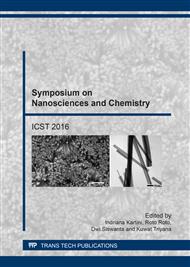[1]
Yuliani, G., A.L. Chaffee, and G. Garnier, Biorefinery process water effluent treatments by salt coagulation. Biomass Bioenerg., 56 (2014) 189.
DOI: 10.1016/j.biombioe.2013.04.027
Google Scholar
[2]
Pokhrel, D. and T. Viraraghavan, Treatment of pulp and paper mill wastewater - a review. Sci. Total Environ., 333 (2004) 37-58.
DOI: 10.1016/j.scitotenv.2004.05.017
Google Scholar
[3]
Singh, S., et al., Investigation of the biotransformation of pentachlorophenol and pulp paper mill effluent decolorisation by the bacterial strains in a mixed culture. Bioresource Technol., 99(13) (2008) 5703-5709.
DOI: 10.1016/j.biortech.2007.10.022
Google Scholar
[4]
Chandra, R., et al., Characterisation and optimisation of three potential aerobic bacterial strains for kraft lignin degradation from pulp paper waste. Chemosphere, 67(4) (2007) 839-846.
DOI: 10.1016/j.chemosphere.2006.10.011
Google Scholar
[5]
Yuliani, G., et al., Lignite clean up of magnesium bisulphite pulp mill effluent as a proxy for aqueous discharge from ligno-cellulosic biorefinery. Biomass Bioenerg., 36 (2012) 411.
DOI: 10.1016/j.biombioe.2011.11.012
Google Scholar
[6]
Srivastava, V.C., I.D. Mall, and I.M. Mishra, Treatment of pulp and paper mill wastewaters with poly aluminum chloride and bagasse fly ash. Colloids Surf. A: Physicochem. Eng. Asp., 260 (2005) 17-28.
DOI: 10.1016/j.colsurfa.2005.02.027
Google Scholar
[7]
Khaled, B., B. Wided, and H. Bechir, Investigation of electrocoagulation reactor design parameters effect on the removal of cadmium from synthetic and phosphate industrial wastewater. Arab. J. Chem., (2015).
DOI: 10.1016/j.arabjc.2014.12.012
Google Scholar
[8]
Shankar, Removal of Lignin from Wastewater through Electrocoagulation. World J. Environ. Eng., 1(2) (2013) 16-20.
Google Scholar
[9]
Mollah, M.Y.A., et al., Electrocoagulation (EC) – science and applications. J. Hazard. Mater., B84 (2001) 29-41.
Google Scholar
[10]
Kalyani, K.S.P., N. Balasubramanian, and C. Srinivasakannan, Decolorization and COD reduction of paper industrial effluent using electro-coagulation. Chem. Eng. J., 151 (2009) 97-104.
DOI: 10.1016/j.cej.2009.01.050
Google Scholar
[11]
Ugurlu, M., et al., The removal of lignin and phenol from paper mill effluents by electrocoagulation. J. Environ. Manage., 87 (2008) 420-428.
DOI: 10.1016/j.jenvman.2007.01.007
Google Scholar
[12]
Vepsӓlӓinen, M., Electrocoagulation in the treatment of industrial water and wastewater, in Department of Chemistry 2012, University of Jyväskylä: Finland.
Google Scholar
[13]
Vepsäläinen, M., et al., Sep. Purif. Technol., 81(2) (2011) 141-150.
Google Scholar


